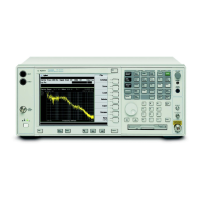The following tables show how to reconstruct the First Conjugate Term for all
possible sign entries in the synthesis table. Since both the real and imaginary
parts of the residue can be minus, there are four possible table entries for
residues (see table 15-1). Since only the real part of the pole can be minus,
there are only two possible table entries for poles (see table 15-2). Table 15-1
shows the numerator constant and table 15-2 shows its denominator for
example table entries.
Table 15-1.
Reconstructing the First Conjugate Term: Residue
Table Entry Numerator Constant (residue)
.5 ±j 1.0 .5 + j 1.0
−.5 ±j1.0 −.5 + j 1.0
−.5 ±j −1.0 −.5 − j1.0
.5 ±j −1.0 .5 − j1.0
Table 15-2.
Reconstructing the First Conjugate Term: Pole
Table Entry Denominator (pole)
.6 ±j2.0 s− .6 − j2.0
−.6 ±j 2.0 s + .6 − j2.0
Agilent 35670A
Operator's Guide Synthesis Option 1D3
15-9
